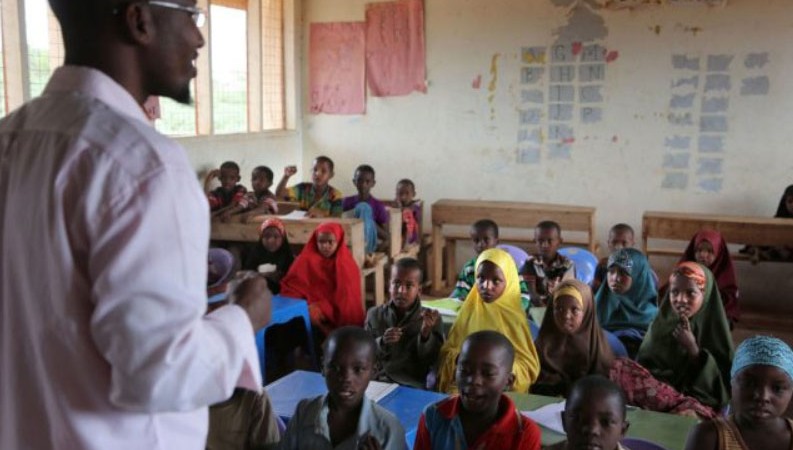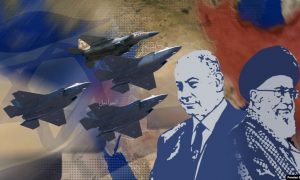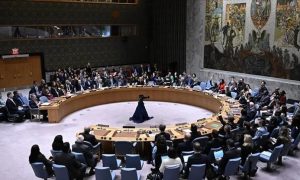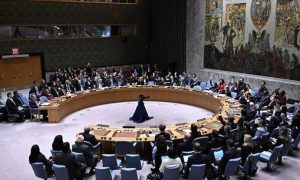
Dadaab, in northern Kenya near Somalia’s border, is the world’s largest refugee camp. More city than camp. More prison than city. Is this the future for refugees?
By: Michelle Shephard | National Security Reporter | Sep 21 2015 |
DADAAB, KENYA—There are no guards patrolling the perimeter where the rows and rows of tarp-covered domes end and Kenya’s unforgiving desert stretches to Somalia in the east and north to Ethiopia.
Dadaab is the world’s largest refugee camp, where the United Nations says 350,302 people live, although the population is more likely half a million.

Next year the camp, set up as emergency shelter from Somalia’s civil war, will pass a grim milestone — 25 years in existence.
Dadaab attracts little attention, unless a famine or terrorist attack in Kenya jolts us into awareness.
Earlier this year, Al Shabab attacked Garissa University College, about a 90-minute drive from here. It was Kenya’s worst terrorist attack in more than two decades, with dozens wounded and 148 students killed. “The way America changed after 9/11 is the way Kenya will change after Garissa . . . We must secure this country at whatever cost,” said Kenya’s Deputy President William Ruto.

He then threatened to expel Dadaab’s refugees to Somalia if it was not closed in 90 days.
Later it became clear that the attackers were Kenyans, including the son of a Kenyan government official. But Dadaab nevertheless became the scapegoat. And while Kenya responded to outside pressure and backtracked, the threat underscored how precarious the lives of refugees are. Even after a quarter of a century.

The camp grew quickly as Somalia’s crisis worsened. Although the refugees remain connected to the outside world through cellphones and spotty internet service, they are trapped, forbidden from travelling anywhere except back home. Here, a woman talks on a cellphone at a distribution centre, where refugees come every 15 days to get food rations.
Meanwhile, the camp residents, some of whom were born here, carried on. The camp is remarkably resilient and vibrant. The thriving market places are run by local residents or entrepreneurial refugees. Shop owners hawk cellphones alongside stalls selling goat meat, the humid air smelling of spiced tea and diesel.
There are more than 50 schools — an education system better than most regions of Somalia — and elected representatives and a local security force that work as liaisons for the United Nations High Commissioner for Refugees (UNHCR).
Despite its permanency, the homes where the refugees live are either plastic tents, or structures fashioned from mud, thorn bushes and corrugated iron. The Kenyan government forbids anything else.
Refugees worldwide live at the mercy of their host country and the relationship, as it is here, is often marred by xenophobia or racism and complicated by the politics of a brutal civil war, or lives crushed by poverty.
The United Nations refugee agency stated last month that there are more displaced people in the world today than ever previously recorded. Nearly 60 million people — almost double Canada’s population — have fled their homes. Half are children.
They face two choices: the camps or asylum.
HOPE AND DISPAIR
Faced with bleak futures in the camps, hundreds of thousands have decided to take their chances, opting to pay smugglers and board overloaded boats to cross the Mediterranean, now considered the world’s most dangerous border crossing.
If they land in camps, they are rendered powerless, losing control of their futures. They cannot travel, often they cannot work. They live in a perpetual cycle of dependence, in a never-ending humanitarian crisis. The UN agency administers resettlement — and fewer countries are accepting refugees.
Syria’s conflict has sent hundreds of thousands to Jordan, Turkey, Lebanon and Iraq and into camps that were created as emergency shelters but are fast becoming villages. Za’atari, in a Jordanian desert wasteland much like Dadaab, was built in nine days in July 2012. At first, there were a few hundred. By this summer, the population had swelled to 81,000.
“I think Dadaab is the future,” says Ben Rawlence, a former researcher with Human Rights Watch and author of City of Thorns, about Dadaab, which is to be released in January.
“There are less and less scenarios where refugees are being absorbed into civilian populations, most countries want them encamped. We’re going to have these temporary towns that are in limbo . . . where you have a perfect storm of conditions to keep people cornered.”

Although refugees are unable to work in Kenya, there are thriving markets throughout the five camps. A 2010 study conducted by Kenya’s Department of Refugee Affairs found that the camp’s economy is worth about $25 million (U.S.) a year. Electronics and fabric are sold in this shop.
Mohamed Olow Odowa calls Dadaab his “open-air prison.” He has lived here since 1992.
Odowa, 28, is a chairman of the camp’s volunteer security force. “We’re cops without guns,” he says.
He used to get phone minutes, flashlights and boots from non-governmental agencies but some of the funding has dried up.
Many aid agencies have pulled out because of security fears or financial cutbacks, including the international staff of Médecins Sans Frontières (MSF), who left shortly after the Garissa attack in April. The World Food Program had to reduce food rations to refugees this summer to deal with a funding shortfall.
“My friend from Canada sent me money so I could buy these,” Odowa says, showing off brown cargo pants paid for by a Somali friend who is working in Alberta’s oilfields.
Odowa says accusations that Al Shabab has support throughout the camp are exaggerated. Many living here fled violence at the hands of East Africa’s Al Qaeda group, making the Shabab’s recruiting pitch a tough sell, he says.
But desperate people resort to desperate measures. Inside the camps, rape, assault and theft are common. Foreign visitors, including journalists, are required to hire a Kenyan police escort to travel beyond the guarded UNHCR compound, which has a 6 p.m. curfew.
Foreign workers have been abducted by suspected Shabab sympathizers, or opportunistic criminals and taken into Somalia, including the two Spanish aid workers with MSF who were taken in Dadaab and held for two years before their release in 2013.
Odowa worries about the rise of the Islamic State, also known as ISIS or Daesh, which has not made inroads in East Africa but has successfully recruited Somali members with a promise of a new life. “You can imagine when you’re young, you have no money and a degree . . . What do you expect if Daesh comes calling?” he says.

While Somalia has recently become more stable, there are regions that remain under the control of Al Shabab or are struggling to rebuild after two decades of war — making even Dadaab’s inhospitable climate a more attractive home.
There is no one solution, or one policy for the world’s millions of refugees.
In June, Amnesty International reported that “the global refugee crisis will not be solved unless the international community recognizes that it is a global problem and deals with it as such.”
Two months later, the horrifying deaths of 71 refugees in an abandoned truck in Austria and the haunting image of 3-year-old Alan Kurdi on a beach in Turkey riveted the world and moved many to action.
German Chancellor Angela Merkel said her country would take hundreds of thousands of refugees annually for years to come. Border rules were eased, allowing thousands of Syrians to seek refuge in Germany.
But her swift action was met with an equally swift backlash. Hungarian Prime Minister Viktor Orban denounced the surge of refugees crossing into his country from the Balkans, accusing them of having “rebelled against Hungarian legal order.” Border controls in Europe were reinstated and an emergency effort led by Germany to mandate refugee quotas for EU states collapsed.
The strife this week suggests more camps like Dadaab will be built, and will endure.
The first refugees at Dadaab did not envision still being there 25 years later and they may be there for 25 more if peace in Somalia is the only way to close the camp.
“You’ve got to differentiate the refugees. You’ve got to stop treating them as a mass of people and you’ve got to realize there are many different groups who have come at different points, who have different options back home, who have different levels of income and education,” says Ben Rawlence, the author of City of Thorns, a book about Dadaab to be released in January.
Refugees can leave Dadaab in three ways: return home (to Somalia, South Sudan, Ethiopia or other countries), resettle in a third country, or obtain citizenship in Kenya.
Although many of the residents were born and raised in Kenya, speak Swahili and identify as Kenyan, few will attain citizenship.
Kenyans of Somali heritage have long complained about discrimination by security forces and immigration officials, and the Kenyan government is not eager to grant Somalis a permanent home.
Finding settlement elsewhere is just as difficult. Most countries that were once generous in accepting refugees, including Canada, are turning away thousands of applicants.
Canadian Immigration and Refugee Board statistics show a steady decline in the number of those settled. In 2011, the board approved 12,932 refugees. Last year, just 5,846 were accepted.
Only 3,338 Somali refugees have voluntarily returned home since the agreement to help facilitate repatriations was signed by the UN refugee agency and the Somali and Kenyan governments in 2013.
Many refugees complained that in addition to security concerns, they were being encouraged to return to places they may no longer recognize — their homes, livestock or businesses long gone. “They give you about $100, enough for a bus ticket,” was a comment often heard.
The UN refugee agency has an acronym to describe refugees in Dadaab — “P.R.A.”
It means “protracted refugee situation” and is defined as a group of more than 25,000 refugees, from one country, being encamped for more than five years.
It is estimated that two-thirds of the global refugee population in this category.
That number is expected to rise.
.
.
____________________________
_____________________________________________________________________________________
Xafiiska Wararka Qaranimo Online | Mogadishu, Somalia
_____________________________________________________________________________________Advertisement
_____________________________________________________________________________________








